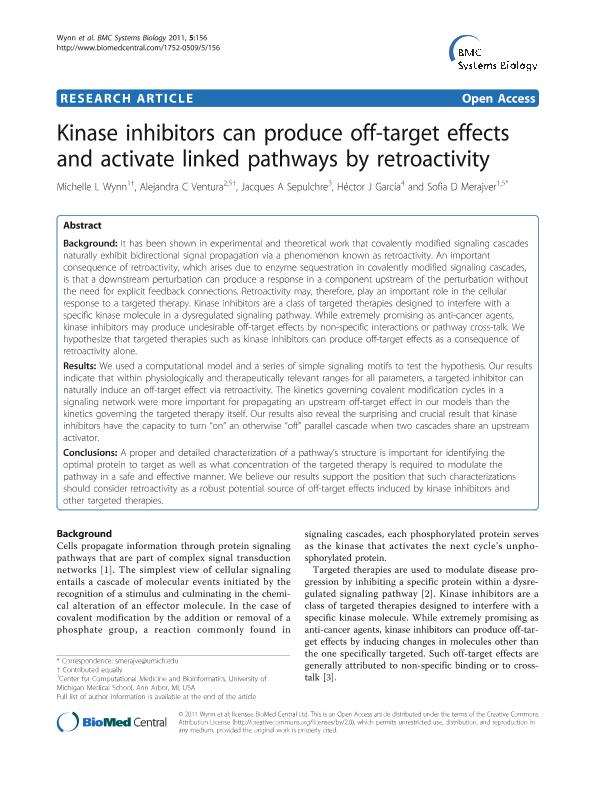Mostrar el registro sencillo del ítem
dc.contributor.author
Wynn, Michelle L.
dc.contributor.author
Ventura, Alejandra

dc.contributor.author
Sepulchre, Jacques Alexandre

dc.contributor.author
García, Héctor J.
dc.contributor.author
Merajver, Sofia D.
dc.date.available
2019-11-21T21:24:08Z
dc.date.issued
2011-10
dc.identifier.citation
Wynn, Michelle L.; Ventura, Alejandra; Sepulchre, Jacques Alexandre; García, Héctor J.; Merajver, Sofia D.; Kinase inhibitors can produce off-target effects and activate linked pathways by retroactivity; BioMed Central; Bmc Systems Biology; 5; 156; 10-2011; 1-15
dc.identifier.issn
1752-0509
dc.identifier.uri
http://hdl.handle.net/11336/89494
dc.description.abstract
Background: It has been shown in experimental and theoretical work that covalently modified signaling cascades naturally exhibit bidirectional signal propagation via a phenomenon known as retroactivity. An important consequence of retroactivity, which arises due to enzyme sequestration in covalently modified signaling cascades, is that a downstream perturbation can produce a response in a component upstream of the perturbation without the need for explicit feedback connections. Retroactivity may, therefore, play an important role in the cellular response to a targeted therapy. Kinase inhibitors are a class of targeted therapies designed to interfere with a specific kinase molecule in a dysregulated signaling pathway. While extremely promising as anti-cancer agents, kinase inhibitors may produce undesirable off-target effects by non-specific interactions or pathway cross-talk. We hypothesize that targeted therapies such as kinase inhibitors can produce off-target effects as a consequence of retroactivity alone.Results: We used a computational model and a series of simple signaling motifs to test the hypothesis. Our results indicate that within physiologically and therapeutically relevant ranges for all parameters, a targeted inhibitor can naturally induce an off-target effect via retroactivity. The kinetics governing covalent modification cycles in a signaling network were more important for propagating an upstream off-target effect in our models than the kinetics governing the targeted therapy itself. Our results also reveal the surprising and crucial result that kinase inhibitors have the capacity to turn "on" an otherwise "off" parallel cascade when two cascades share an upstream activator.Conclusions: A proper and detailed characterization of a pathway's structure is important for identifying the optimal protein to target as well as what concentration of the targeted therapy is required to modulate the pathway in a safe and effective manner. We believe our results support the position that such characterizations should consider retroactivity as a robust potential source of off-target effects induced by kinase inhibitors and other targeted therapies.
dc.format
application/pdf
dc.language.iso
eng
dc.publisher
BioMed Central

dc.rights
info:eu-repo/semantics/openAccess
dc.rights.uri
https://creativecommons.org/licenses/by-nc-sa/2.5/ar/
dc.subject
CELL SIGNALING
dc.subject
RETROACTIVITY
dc.subject
KINASE INHIBITORS
dc.subject.classification
Otras Ciencias Físicas

dc.subject.classification
Ciencias Físicas

dc.subject.classification
CIENCIAS NATURALES Y EXACTAS

dc.title
Kinase inhibitors can produce off-target effects and activate linked pathways by retroactivity
dc.type
info:eu-repo/semantics/article
dc.type
info:ar-repo/semantics/artículo
dc.type
info:eu-repo/semantics/publishedVersion
dc.date.updated
2019-09-30T15:24:08Z
dc.journal.volume
5
dc.journal.number
156
dc.journal.pagination
1-15
dc.journal.pais
Reino Unido

dc.journal.ciudad
Londres
dc.description.fil
Fil: Wynn, Michelle L.. University of Michigan Medical School; Estados Unidos
dc.description.fil
Fil: Ventura, Alejandra. Consejo Nacional de Investigaciones Científicas y Técnicas. Oficina de Coordinación Administrativa Ciudad Universitaria. Instituto de Fisiología, Biología Molecular y Neurociencias. Universidad de Buenos Aires. Facultad de Ciencias Exactas y Naturales. Instituto de Fisiología, Biología Molecular y Neurociencias; Argentina. Universidad de Buenos Aires. Facultad de Ciencias Exactas y Naturales. Departamento de Fisiología, Biología Molecular y Celular. Laboratorio de Fisiología y Biología Molecular; Argentina. University of Michigan Medical School; Estados Unidos
dc.description.fil
Fil: Sepulchre, Jacques Alexandre. Centre National de la Recherche Scientifique; Francia
dc.description.fil
Fil: García, Héctor J.. University of Michigan; Estados Unidos
dc.description.fil
Fil: Merajver, Sofia D.. University of Michigan Medical School; Estados Unidos
dc.journal.title
Bmc Systems Biology

dc.relation.alternativeid
info:eu-repo/semantics/altIdentifier/url/https://bmcsystbiol.biomedcentral.com/articles/10.1186/1752-0509-5-156
dc.relation.alternativeid
info:eu-repo/semantics/altIdentifier/doi/http://dx.doi.org/10.1186/1752-0509-5-156
Archivos asociados
